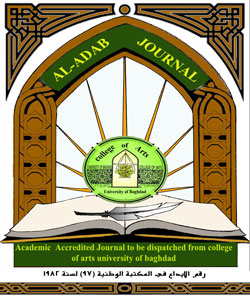Religions Viewpoints of Khalil Jubran (Khalil Gibran)
A Critical Review
DOI:
https://doi.org/10.31973/aj.v0i129.589Keywords:
individualistic religion, freedom of religion, romantic, Jubran Khalil Jubran, religious viewpointsAbstract
Jubran Khalil Jubran was one of the thousands Lebanese youth who emigrated with his family to the United States because of inappropriate social, political and financial situations. Using his great potentialities, he became on of the most influential figures of the world in thinking, literary, and art dimensions.
This study attempts to investigate 1)the influential and challenging character of Khalil Jubran in the Arab world, Europe, and America; 2) the challenging religious and literary viewpoints presented by Khalil Jubran; 3) his distinguished and unique viewpoints about ontology, religion, human, and society; 4) having freedom of religious expression with a specific and non-imitative style; 5) management and guidance of the Northern Mahjar academy; 6) great realization of humanistic and moral attitudes in his works; 7)deep contemplation in human mental and behavioral states and materializing them in different works of poetry, prose and essay; and 8)lack of religious and sectarian prejudice. Although he was born to a catholic family, his personality reflected Christianity thinking, Islam, and Buddhism; and great figures such as Jesus, Imam Ali, Buddha, Abolala Moeri, William Blake, William Wordsworth, Coleridge, Nietzsche, famous European and American novelist provided him with highly valuable experiences. A lot of his viewpoints are consistent with Islamic views. A few inconsistencies are, however, observed in relation to transpiration of the soul or transmogrification, a global single or common religion, contradiction between propagating religious unity and advocacy of legitimacy of multiplicity in thinking and morality; giving love to all humans even to the cruel and murderers! and frangibility and instability of religious beliefs because of integration of the origin of his thought, which will be investigated and criticized in this study.
Downloads
References
Amini, Amirgholi (1362). Folklore, second edition, Isfahan, University of Isfahan Publications.
Bashrooii, S. Translated by Mehrdad Entezari. (1382). Jubran Khalil Jubran, a man and a poet, first edition. Tehran, Badraghe and Namak Publication.
Dashti and Mohammadi (1418 H. H). Almojam.
Hoseini, S. R. (1366). Literary schools. Tehron, Neil and Negah Publication.
Jafari, M. (1378). Romantic History in Europe. Tehran, Markaz Nashr Publication.
Jubran, M. (1986). Al Raēd, vol.1, fifth edition, Beirut, Darol Elm for scholars Publication.
Khalil Jubran, J. (1949). Comprehensive works, Almoosighi.
Khalil Jubran, J. (1949). Comprehensive works, Damā and Ibtesamā.
Khalil Jubran, J. (1918). Comprehensive works, Al Magnoon.
Khalil Jubran, J. (1923). Comprehensive works, Prophet.
Khalil Jubran, J. (1926). Comprehensive works, Raml and Zabad.
Khalil Jubran, J. (1928). Comprehensive works, Yassoo Ibn Insan.
Khalil Jubran, J. (1949). Comprehensive works, Al Awasef.
Khalil Jubran, J. (1949). Comprehensive works, Albadaē Al Taraef.
Khalil Jubran, J. (1949). Comprehensive works, AlMawakeb.
The holy Quran
Downloads
Published
Issue
Section
License
Copyright and Licensing:
For all articles published in Al-Adab journal, copyright is retained by the authors. Articles are licensed under an open access Creative Commons CC BY 4.0 license, meaning that anyone may download and read the paper for free. In addition, the article may be reused and quoted provided that the original published version is cited. These conditions allow for maximum use and exposure of the work.
Reproducing Published Material from other Publishers: It is absolutely essential that authors obtain permission to reproduce any published material (figures, schemes, tables or any extract of a text) which does not fall into the public domain, or for which they do not hold the copyright. Permission should be requested by the authors from the copyrightholder (usually the Publisher, please refer to the imprint of the individual publications to identify the copyrightholder).
Permission is required for: Your own works published by other Publishers and for which you did not retain copyright.
Substantial extracts from anyones' works or a series of works.
Use of Tables, Graphs, Charts, Schemes and Artworks if they are unaltered or slightly modified.
Photographs for which you do not hold copyright.
Permission is not required for: Reconstruction of your own table with data already published elsewhere. Please notice that in this case you must cite the source of the data in the form of either "Data from..." or "Adapted from...".
Reasonably short quotes are considered fair use and therefore do not require permission.
Graphs, Charts, Schemes and Artworks that are completely redrawn by the authors and significantly changed beyond recognition do not require permission.
Obtaining Permission
In order to avoid unnecessary delays in the publication process, you should start obtaining permissions as early as possible. If in any doubt about the copyright, apply for permission. Al-Adab Journal cannot publish material from other publications without permission.
The copyright holder may give you instructions on the form of acknowledgement to be followed; otherwise follow the style: "Reproduced with permission from [author], [book/journal title]; published by [publisher], [year].' at the end of the caption of the Table, Figure or Scheme.











